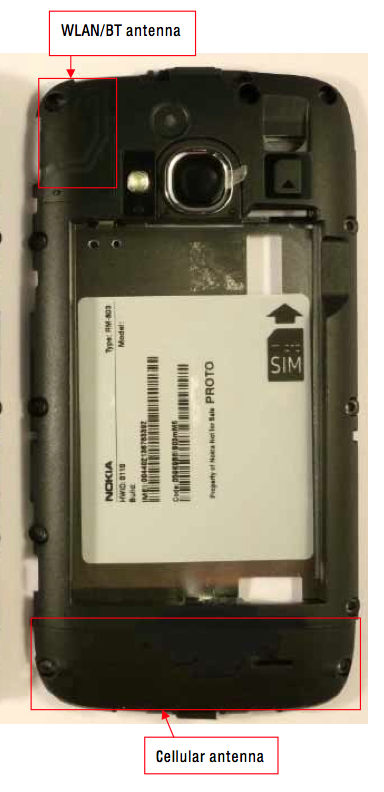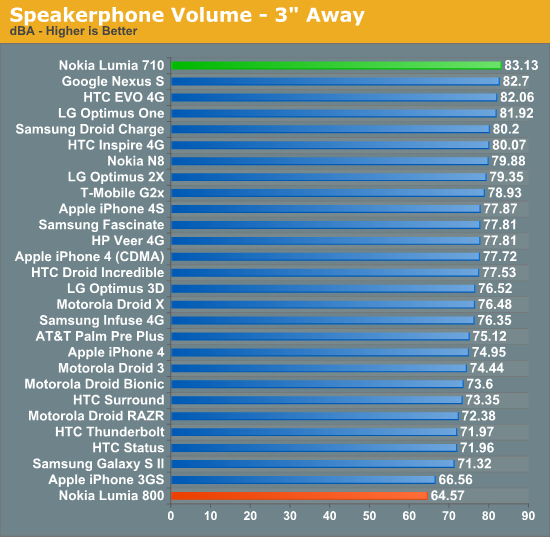Nokia Lumia 710 Review - T-Mobile's Nokia WP7
by Brian Klug on January 5, 2012 12:01 AM EST- Posted in
- Smartphones
- Nokia
- Mobile
- WP7
- Lumia 710
Cellular
Like all MSM8255 devices, the Lumia 710 uses Qualcomm’s onboard combination GSM/EDGE/WCDMA HSPA+ baseband for cellular connectivity. That means HSDPA category 10 on the downlink and HSUPA category 6 on the uplink. Of course, the fact that these HSDPA/HSUPA categories are nothing special at all right now for WCDMA means nothing to T-Mobile, who gladly replaces the “3G” indicator with “4G”.
| Nokia Lumia 710 - Network Support | |||||
| GSM/EDGE Support | 850 / 900 / 1800 / 1900 MHz | ||||
| RM-803 (Europe) WCDMA Support | 900 / 1900 / 2100 MHz (I, II, VIII) | ||||
| RM-809 (T-Mobile USA) WCDMA Support | 850 / 1700 / 1900 / 2100 MHz (I, II, IV, V) | ||||
| Baseband Hardware | QCT MDM8255 w/QTR8615 | ||||
| HSPA+ Categories | HSDPA 14.4 (Cat.10) / HSUPA 5.76 (Cat.6) | ||||
The other noteworthy thing is that the Lumia 710 is also subdivided into two different revisions which carry different WCDMA bands - we were sampled the RM-809 which includes T-Mobile AWS (1700/2100) support. What’s interesting about the RM-809 is that the device also has support for PCS 1900 and Cellular 850, which which means it would work on AT&T, though our device wasn’t unlocked and thus we weren’t able to try. The FCC approval is in place, however. The other Lumia 710 is geared for international support with bands 1, 2, and 8.

I had no issues at all with the Lumia 710 on cellular - connectivity is excellent. Unfortunately I couldn’t get Field Test on the 710 working to read out dBm and check for deathgrip (for some reason it loads indefinitely), however I didn’t see anything odd in my time with the device. In addition I ran speedtests and saw throughput on par with what I expect out of T-Mobile’s HSPA+, though none of the speedtest applications on WP7 allow me to export data and make a nice histogram or two.
WiFi
WLAN connectivity on the Lumia 710 is the standard fare for almost all smartphones these days - 802.11b/g/n (2.4 GHz) single stream. On 20 MHz WLAN channels, that means a physical rate of 72 Mbps, which is precisely what I saw the Lumia 710 authenticate as. I wasn’t able to completely verify, but it seems like a safe bet that BCM4329 is lurking inside. In addition, range signal performance are spot on with where they should be, I saw no issues in my testing.
In our throughput test I saw speeds that almost matched the Lumia 800 (which isn’t surprising at all).

Speakerphone
I spoke a lot about how the Lumia 800’s speakerphone was way too quiet. If the Lumia 800 is one side of the spectrum, the 710 is on the complete other side, as its speakerphone is eardrum-shatteringly loud. In our sound datalogger test, the Lumia 710 placed literally at the top of the ranks for volume, so if you absolutely need speakerphone volume the 710 is an excellent pick. Earpiece volume is also subjectively top notch.

In the call quality department I did the usual thing and recorded samples from the 710 on line in, placed a few calls, and tested noise rejection. The 710, like all WCDMA devices, sounds great to me, though GSM call quality is a bit reduced.
The Lumia 710 does do noise rejection, which has worked its way down from the $200 “superphone” category all the way to the $50 category over the last year or so. The device does common mode noise rejection and some fancy DSP to isolate and cancel noise, and though I’m not sure what IP is in place here (possibly Qualcomm’s Fluence since I don’t see a discrete solution on the board) it does a good job in our test.
GPS
The Lumia 710 unsurprisingly uses the GPS/GLONASS (GNSS) system onboard MSM8255 and accompanied by QTR8615 which we’ve seen numerous times before. Though WP7 doesn’t have API access to NMEA data so we can see SNR from individual satellites, the Lumia 710 does seem to get a GPS lock speedily enough even in some tough environments. In both the maps application and Nokia Drive I had no issues getting a GPS lock in under 5 seconds and keeping the lock for the duration of navigation.










48 Comments
View All Comments
augustofretes - Monday, January 9, 2012 - link
You lied to us :( XDKTGiang - Thursday, January 5, 2012 - link
The Nokia Luma710 isn't the "midrange" product for Nokia. The 800 is the "midrange" product and they haven't announced their high end product for the US yet. I do agree that Nokia doesn't make too much sense right now but at the same time I don't exactly own a successful phone manufacturing company.Brian Klug - Thursday, January 5, 2012 - link
That's true, I guess I should state that at present those labels are relative - only the 710 and 800 are announced. (Though we'll see what happens at CES...)-Brian
KTGiang - Thursday, January 5, 2012 - link
Yup, you did some good editing for better accuracy. Only people who are up on their Windows Phones news knows that Nokia actually gave a statement saying they didn't release the Lumia 800 in the US because they wanted to make sure they released a proper high end phone to compete in the market over here. Also, they wanted to establish a base and buzz in the rest of the world with the Lumia 800 where they still have phones in the hands of their consumers.name99 - Thursday, January 5, 2012 - link
You get judged by what you SHIP not by what you plan one day to ship.You know what's a truly awesome phone, way better than ALL this crap Anand is talking about --- the iPhone 7! Man, that thing makes a Lumia 710 look like a Nokia 6235 candybar.
jjj - Thursday, January 5, 2012 - link
In the US it's all about the high end,the consumer is quite a different beast from most other places and to be fair the price difference is pretty small.Why T-Mo and the 710? Nokia most likely has better relations with T-Mo than with the other US carriers so it was easier to bring the device to market fast and they didn't wanted to give a higeher end device to the smallest of the big 4 or maybe nobody was interesting in heavily subsidizing the 800.As for the device itself i'm not sure it's a better buy than the HTC Radar 4G.
For the ecosystem,it's hard to have faith in Microsoft,they are slow and afraid to innovate,the Windows brand doesn't have the best image and the first steps towards an OS unification are not great.Win 8 might be Vista 2 for traditional PC users.If they don't let us disable the Metro UI on desktops, i know i won't upgrade to Win8,don't need the extra bloat. They'll keep trying to buy their way in,just like they are doing with Bing ( terrible search engine BTW and i use it often) but they need to do better to actually succeed.
dagamer34 - Thursday, January 5, 2012 - link
Afraid to innovate? Have you SEEN Windows 8??jjj - Thursday, January 5, 2012 - link
have you,or you just have a vague idea about what it is?Nataku - Thursday, January 5, 2012 - link
u really just sound like u have a grudge towards microsoft now... i've used the dev preview, i admit its not that great for keyboard/mouse use but definitely works wonders once you get touch screen, but thats only the dev preview and ms said they would do something about it (otoh, the new task manager is great)now about innovation, xbox was definitely innovative, wp7/zune dont get enough credit they are some of the the most innovative product as well, sky drive is fantastic now with the new update and fix they have in place (still hate the 100mb file limit though...)
Microsoft isn't the monstrosity it used to be, they actually listen to customers now and do things right, give them another chance
Samus - Thursday, January 5, 2012 - link
still a shame the Venue Pro is the ONLY WP7 with a keyboard...